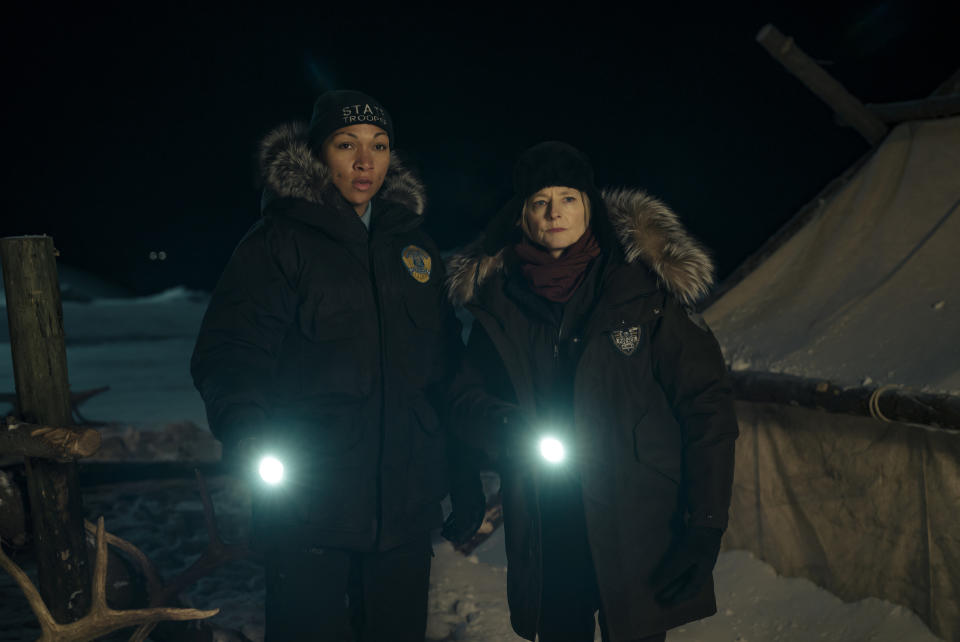How Issa López Created the Most Haunting Season of ‘True Detective’ Yet
HBO’s “True Detective: Night Country” is the most haunting and eerie season of “True Detective” yet, a result of showrunner and director Issa López‘s willingness to explore harrowing questions and her ability to find the precise visual corollaries for her characters’ isolated, traumatized inner states. Although “Night Country” shares DNA with Nic Pizzolatto and Cary Joji Fununaga’s first season in its core idea — which López described to IndieWire’s Filmmaker Toolkit podcast as “the sense that something very rotten is coming to the surface” — López was determined to approach the series’ pitiless tone in a fresh way.
So instead of making the series hot and masculine like the first season’s Louisiana-set story of two male police detectives, López went cold and feminine, following cops Jodie Foster and Kali Reis as they try to solve a mystery in arctic Alaska. That meant taking a deep dive into the region since, as a Mexican based in Los Angeles, López was cheerfully unfamiliar with freezing temperatures. “When I grew up, we had snow one time outside of Mexico City, and everybody drove there to see 2 inches of snow,” she said. “That was my experience of snow.” Once López traveled to Northern Alaska and experienced how people there worked and lived, she became completely fascinated.
More from IndieWire
“The first question that comes to mind is why do people even live there?” López said. “It’s so removed from our own experience that the only way to understand it is to stand there. It creates its own set of rules and its own reality. So the challenge was, how can I illustrate this without making it into an information pile-up?” Ultimately, López decided to trust the story and let the physical details emerge organically from the murder mystery, which asks philosophical questions similar to the ones that emerged throughout the first three seasons of “True Detective.” “When you’re in the darkness of the American Arctic, what is the response to the question of whether the universe is indifferent? Is chaos going to devour us all? Is there a higher purpose? Is there a divine principle in the world, or are we all alone?”

The loneliness at the center of the story is beautifully conveyed by the cinematography, which consists largely of night exteriors and dimly lit interiors since it takes place during a period when the sun never comes out. “When I started interviewing DPs for this, it was almost embarrassing to say, ‘We’re going to go to the most stunning place on earth, and the whole point is not to see it,” López said. (The series was shot in Iceland for logistical reasons.) Luckily, her cinematographer Florian Hoffmeister (“Tár”) was on board with the idea. “Florian had this beautiful idea that instead of fighting the dark, you should fight the light. Embrace the dark and leave in the spots of light, but always have darkness visiting the frame. So even in a lot of our interiors, if you look at the way he designed the colors and the light, there’s a chiaroscuro.”
That chiaroscuro was another extension of the philosophical center of the series, which focuses on what’s hiding in the dark or beneath the surface. For López, it was important that the show operates on multiple levels throughout so that for each component of the murder mystery, there were both earthbound and spiritual interpretations that could be equally plausible. “There is a way to read every single one of the events that needs no supernatural elements,” López said. “But at the same time, there is a way to read every single event as guided by higher forces.” This duality has been an essential component of López’s filmmaking not only in “North Country” but in feature films like “Tigers Are Not Afraid.” “I think it comes from my culture, the fact that Mexico is a country that carries this massive spiritual baggage and this very complex relationship with death and the dead. But at the same time, it embraces science, and we have to be both to be modern Mexicans. And the way that we have to balance horror and incredible beauty in our everyday life informs my storytelling.”
Best of IndieWire
The 13 Best Thrillers Streaming on Netflix in May, from 'Fair Play' to 'Emily the Criminal'
The Best Father and Son Films: 'The Tree of Life,' 'The Lion King,' and More
The 10 Best Teen Rebellion Films: 'Pump Up the Volume,' 'Heathers,' and More
Sign up for Indiewire's Newsletter. For the latest news, follow us on Facebook, Twitter, and Instagram.

 Yahoo News
Yahoo News 
